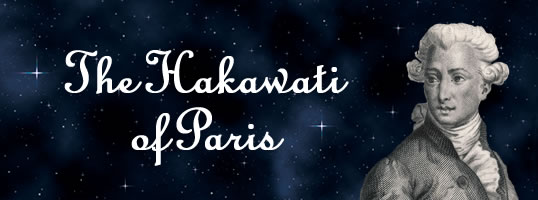 |
| J. CAZON / MARY EVANS PICTURE LIBRARY |
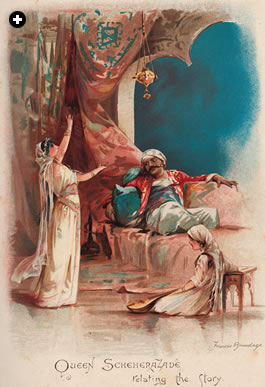 |
| FRANCES BRUNDAGE / BLUE LANTERN STUDIO / CORBIS |
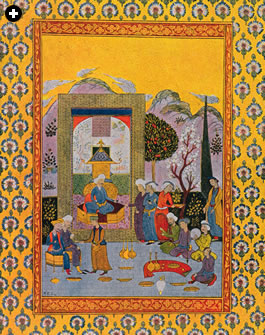 |
| PRIVATE COLLECTION, ROGER PERRIN / BRIDGEMAN ART LIBRARY |
| Top: Scheherazade begins her tales, circa 1893. Above: A color engraving, in Persian miniature style, from an 1895 French edition of Les Mille et Une Nuits. |
Written by Pamela D. Toler
Paris, 1713: A cheerful crowd gathers below Antoine Galland’s bedroom window, calling his name. When the 67-year-old scholar appears in his nightshirt, they ask him,
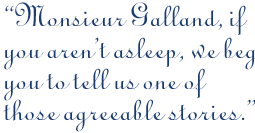
They settle down to hear a tale from Galland’s newly translated Les Mille et Une Nuits (The Thousand and One Nights), better known in English as The Arabian Nights, then at its peak of popularity.
Antoine Galland was an unlikely Scheherazade. Born in 1646, he studied to be a classical scholar, and from 1670 to 1675 served as an interpreter for the French diplomatic mission in Constantinople. There, he studied Turkish, modern Greek, Arabic and Persian. Back in France, he became a curator of the royal collection of coins and medals, and he made two additional trips to the Levant to acquire manuscripts for the royal collection. He held the chair of Arabic at the Collège Royal from 1709 until his death in 1715. Over the course of his career, he transcribed and translated manuscripts from Turkish, Persian and Arabic, including another book of tales, The Indian Tales and Fables of Bidpai and Lokman. Galland was a student of the great orientalist scholar Barthélemy d’Herbelot, and after d’Herbelot’s death he completed and published his teacher’s monumental Bibliothèque Oríentale, which served as the standard European reference work on the Middle East and India well into the 19th century.
The Thousand and One Nights was a diversion for Galland. He worked on the tales after dinner as a way to relax after a long day of scholarship. Ironically, as he told Dutch epigrapher and numismatist Gisbert Cuper in a letter in 1705, “that book of idle tales brings me more honor in the world than the most beautiful work I can compose about coins, full of erudite remarks on Greek and Roman antiquities.”
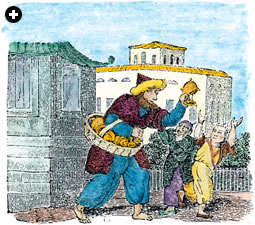 |
| MARY EVANS PICTURE LIBRARY |
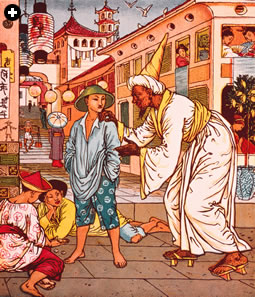 |
| WALTER CRANE / BRITISH LIBRARY / BRIDGEMAN ART LIBRARY |
| Top: An 1851 edition published in Philadelphia combines motifs from China, the Middle East and Turkey. Above: an 1878 illustration of “Aladdin accosted by a magician” is set in an imaginary China. |
The Arabic Alf Layla wa Layla, from which Galland drew his Thousand and One Nights, was not, strictly speaking, a text. Rather, it was a body of oral tradition—popular tales told by street entertainers, based on folklore that stretched from India to Egypt. Each storyteller augmented plots, embroidered descriptions and filled the tales with literary allusions and quotations to reflect both his own taste and that of his audience. Over time, Arab literati collected the stories, much as Jakob and Wilhelm Grimm collected fairy tales from German peasants in the 19th century, and the tales in the resulting manuscripts varied according to the time and place they were heard and the taste of the man compiling the collection. The framing story of Scheherazade, who tells stories each night to the Sultan of Persia and the Indies in a clever fight for her life, appears in an Arabic translation of a lost Persian story collection as early as the year 850.
For his collection, Galland acquired several manuscripts of collected tales between 1701 and 1704. Scholars have identified two of them: a manuscript version of the “Sinbad the Sailor” tales and a Syrian manuscript of collected tales dating from the 15th century. (Three volumes of the Syrian manuscript—one of the oldest of its kind—are now in the Bibliothèque Nationale in Paris. A possible fourth volume, as well as the original for Sinbad, is lost.) It is likely, based on differences between Galland’s translation and the Syrian manuscript, that Galland also had access to another early manuscript that has not been identified.
In addition, Galland’s journal tells us he used another source: Hanna, a Christian Arab from Aleppo who had traveled to Paris in 1709. Hanna told Galland 14 “very beautiful Arabic stories,” including “Aladdin,” “Ali Baba” and “Prince Ahmed and the Peri Banou.” Galland wrote summaries of the tales in his journal, and the fully developed versions that appeared in volumes nine and ten of the Mille et Une Nuits became some of the most popular in the collection.
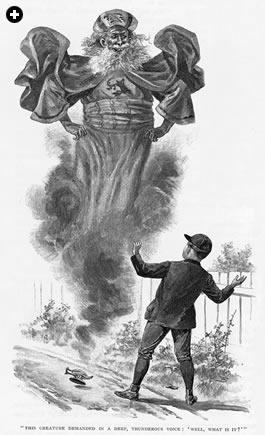 |
| ST. NICOLAS / MARY EVANS PICTURE LIBRARY |
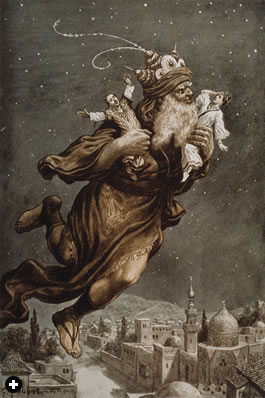 |
| BETTMAN / CORBIS |
| By the late 19th century, the popularity of the tales and the availability of color printing technology inspired illustrators. At top, an American boy rediscovers Aladdin’s lamp in 1894. Above: a similarly bearded “genie,” drawn in 1900, whisks captives over an imaginary cityscape. |
In some ways, Galland was not unlike the hakawati, the Arab coffeehouse storytellers who recounted—and often tailored—familiar tales to their audiences. Galland selected the stories he deemed most suitable for a European audience, and in so doing established a canon of tales for Europeans that is distinct from the original material. Aimed at a courtly rather than a scholarly audience, Galland’s translation was often deliberately inaccurate. As he wrote to Cuper, his version was not “attached precisely to the text, for that would not have given pleasure to the readers. To the extent that it was possible, I have rendered the Arabic into good French without being slavishly attached to the Arabic words.”
In doing so, he adapted the Arabic vernacular style to reflect the then current French literary taste for the precious. He also softened the frequently explicit sexuality of the popular street tales into suggestive coyness, a tone that was the literary equivalent of contemporaneous paintings in the rococo style by Watteau, Boucher or Fragonard. Except for occasional paraphrasing, Galland also excised the frequent passages of verse that were important parts of the tales in their original forms. He eliminated the repetitions that are central to any oral form of literature and inserted contextual explanations of Islamic culture where he believed they were necessary to assist the European reader. He abridged, omitted and altered as required to make the tales suitable for, as he wrote, “our language and our times.”
Galland’s Thousand and One Nights was published in France in 12 small volumes between 1704 and 1717. His timing was good: Charles Perrault’s 1697 Contes de ma Mère Oye (Tales of Mother Goose) had already created an audience in Parisian society for fanciful tales. Galland himself had tested the waters in 1701 with his translation of the seven tales of Sinbad the Sailor, which were later included in volume three of the Nights, and he deliberately targeted the audience that had enjoyed Perrault. He dedicated the first volume of the Nights to his long-time patroness, the daughter of the Comte de Guilleragues, “Madame la marquise d’O, Dame du Palais de Madame la Duchesse de Borgogne,” and the ladies of the court were so impatient to know what happened next that Galland had to lend them manuscript versions that they passed from hand to hand until the next volume was published.
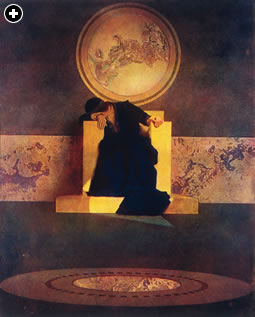 |
| AMERICAN ILLUSTRATORS GALLERY / BRIDGEMAN ART LIBRARY |
| In 1929, Maxfield Parrish, one of the most popular American artists of the early 20th century, combined Neoclassicism and Romanticism with Art Deco graphic design in this color lithograph for the tale “The Young King of the Black Isles.” |
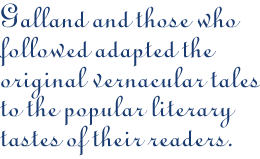
Twelve volumes, however, were not enough: His readers wanted more, and while some of Galland’s later collections were based on actual Arabic manuscripts, others were created from whole cloth by their “translators.”
For the English-speaking audience, the first volumes of the Thousand and One Nights appeared in 1706, in an anonymous translation called the “Grub Street” version, under the name The Arabian Nights Entertainments. As in France, so in England: The tales proved wildly popular, and between 1713 and 1800 more than 40 editions of the Thousand and One Nights and its imitators appeared. Eight years after Gallard’s death, beginning in 1723, the London News ran the collection as a serial over three years and 445 installments; it was only the second book to be published in serial form in England. (The first was Defoe’s Robinson Crusoe.)
It was a long time before anyone attempted a translation into English that wasn’t based on Galland. Between 1839 and 1841, Edward William Lane
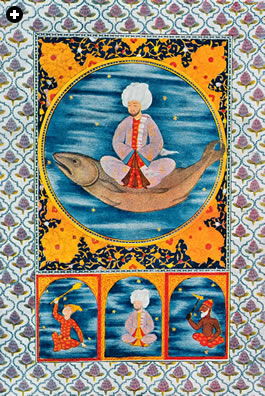 |
| PRIVATE COLLECTION / BRIDGEMAN ART LIBRARY |
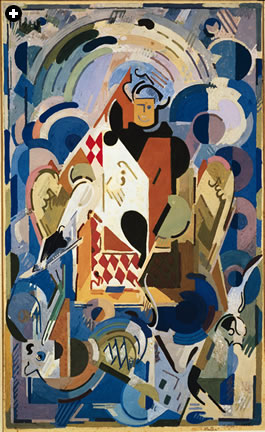 |
| PRIVATE COLLECTION / BRIDGEMAN ART LIBRARY |
| Top: A color engraving for “Abdullah of the Sea,” right, for a French edition in 1895, draws from the miniature tradition. Above: More than two centuries after Galland, French abstract painter Albert Gleizes titled this 1938 painting “Aladdin.” |
published a highly annotated translation of carefully selected episodes in three volumes. From 1882 to 1884, John Payne published a “complete” translation in nine volumes. Richard Burton’s infamous 15-volume translation—10 volumes of text and five volumes of notes—appeared in 1885 and 1886. None, however, eclipsed Galland: The Lane translation is weighed down by the erudition of its footnotes; Payne’s language is ponderously archaic. And Burton’s version is in some ways a reversal of Galland’s: Where Galland translated the tales into “good French,” Burton is burdened by his attempt to write “as the Arab would have written in English.” Where Galland softened sexuality, Burton exaggerated it.
Though each translator claimed to provide a more authentic, accurate and complete translation, none replaced Galland’s in the hearts of English-speaking readers. In fact, later translators, usually working from an Arabic edition known as “Calcutta II,” published there in the 19th century, felt constrained to add versions of “Aladdin” and “Ali Baba” to their translations even though those stories were not included in the Calcutta edition.
In some ways, Galland’s Thousand and One Nights is as much a work of European literature as it is a translation from Arabic. The magic of the tales has been evoked in literary works as diverse as Charles Dickens’s A Christmas Carol and Marcel Proust’s Remembrance of Things Past. Authors as different as Samuel Taylor Coleridge and Jorge Luis Borges have written on how important the Thousand and One Nights was to them as children. Some elements of the tales, such as Aladdin’s lamp and “open sesame!” are now part of our shared cultural vocabulary, no more Arab than pizza is Italian. The very term “Arabian Nights” has become shorthand for a state of enchantment and wonder.
Galland’s tales, still magical, await our return to our childhood copies of the Thousand and One Nights, ready to offer us a rediscovery of enchantment and wonder. All we have to do is murmur,

 |
Free-lance writer Pamela D. Toler ([email protected]) holds a Ph.D. in history from the University of Chicago, where her dissertation focused on British and French orientalism. She lives in Chicago.
|





